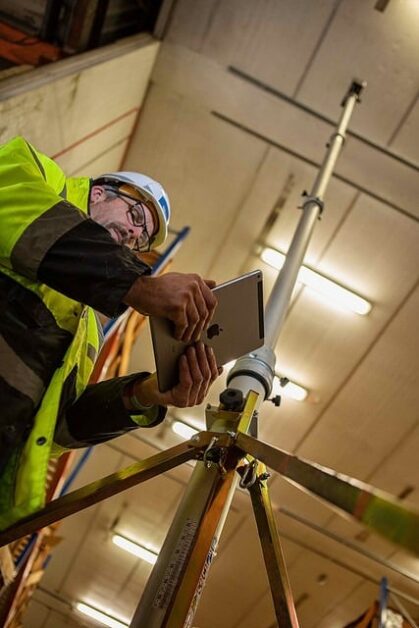
WHAT YOU MUST KNOW BEFORE BUYING A 3D LASER SCANNER
20 February 2019 Off By The Engineering CommunityIn emergent tech sectors it’s common to find start-up companies which are not in command of the core skills required to do their work.
That’s certainly true in the scanning sector.
Like many new industries the sector infrastructure barely exists and for customers, finding a credible service provider can be challenging.

New sectors are like Wild West towns in the 1870s – there may or may not be a sheriff, a marshal, or a judge, and they may or may not have a grip on local law enforcement; they may or may not be well-versed in the law and they’re operating a long way from established civil society.
For customers, it can be a bit of nightmare, so here are a few of the things to look out for.
1. Tech manufacturers need to sell their tech and software, and their key messages often emphasise ease of use and application. Most tech-competent people can get up and running at an extremely basic level, but not with the performance requirements of a company offering professional services for a fee.
It’s only easy to use if you already have high-level intuitive tech skills (we have in-house tech staff who have developed our own training and operational hubs and can do everything, including adapting software and writing code)!
2. There are no generic, industry-wide, approved training courses. Manufacturers (Leica, Z+F, Faro etc) operate differently, manufacture different types of equipment, generating different outputs. Inexperienced companies get confused by this and overwhelmed by the need to learn different systems.
3. People are learning scanning in all sorts of ways – from YouTube and other online sources, and by trial and error (we train scanning operators and those doing post-production in-house, and we’re developing clear training protocols).
4. There’s a divide in the industry, between tech-led firms that have little understanding of BIM / FM / construction / design and build / project management etc; and firms led by people who have all these skills, but whose tech skills are deficient (we have employees with extensive skills and experience in both areas).
5. The entry level costs are peanuts by the standards of many industries; but for the individual sole-trader start-up entrepreneurs who so often pioneer new markets, they’re horrendous! No qualifications are required and most customers have little experience of the tech and haven’t yet acquired the skills to differentiate between a credible and non-credible offer.
Capital apart, the barriers to entry are, therefore, low, and many of the bottom-feeders are people with low-level business skills. (We have a successful, profitable, 17-year old company with great credit references and access to capital).
6. If you’re an individual sole-trader entrepreneurbuying all the equipment and software you need to run a scanning company, you’ll need a fair number of customers – very quickly – to pay-back your start-up costs, so you need to have the skills to grow a business to scale fast.
Why fast? Because the tech is developing so fast that within months / a year or so you’ll need to invest heavily again, to keep pace – and you can’t do that if you haven’t paid-down your initial investment or you can’t raise the capital (we were doing scanning projects across France, Germany and UK within weeks of starting our own operation; we have access to capital, we have a healthy income stream, and we invested in our second generation of technology before even launching a dedicated scanning company).
7. New entrants sometimes fail to realise that one day of scanning could require multiple days of post-production in order to produce something that is useable by most clients.
If you don’t do that, you’ll give the client an output which is clunky, data-heavy, difficult to use and awkward. They won’t get the most out of it, they won’t use it, they’ll consider the money wasted, and they won’t come back for a second bite (we have skilled in-house staff who can process scanned data quickly and make it very easy for customers to use).

8. The software that ‘comes in the box’ with a scanner isn’t sufficient for a professional operation. You need to apply other software, and probably adapt or write software for your specific requirements.
Writing code is simply beyond many of the people who go in to the business (Xmo Strata has always been an IT-literate company and we have introduced numerous IT-led customer solutions; writing code is second nature to our IT staff).
9. Scanning is essentially a professional services operation. Some of the companies in the field simply don’t have the customer-facing communications skills required; their founders have come out of corporates who are used to being on the ‘client’ side of the table and the cultural shift is beyond them (we have run a professional Business-To-Business service company for 17 years).
10. The initial cost of a basic scanner and everything you need to set-up is below six figures, if you do it on the cheap. But some of those in the sector have no experience of running an SME (Small to Medium Sized Enterprise) and think that they can set-up for the cost of the equipment alone.
Undercapitalised companies don’t last very long. If they haven’t provided customers with useable outputs (which is frequently the case) all the work disappears when they go out of business (we have extensive business experience covering not only our own companies but major brands).
The truth is that providing 3D digital scanning and digital modelling as a professional service is not for amateurs; but a generation of amateurs may have to come, and go, along with their customers’ money and much of the work customers have paid for, before that lesson is properly understood.
By Steve Martin, Managing Director, Xmo Strata and ManagingDirector, SpectisGB


